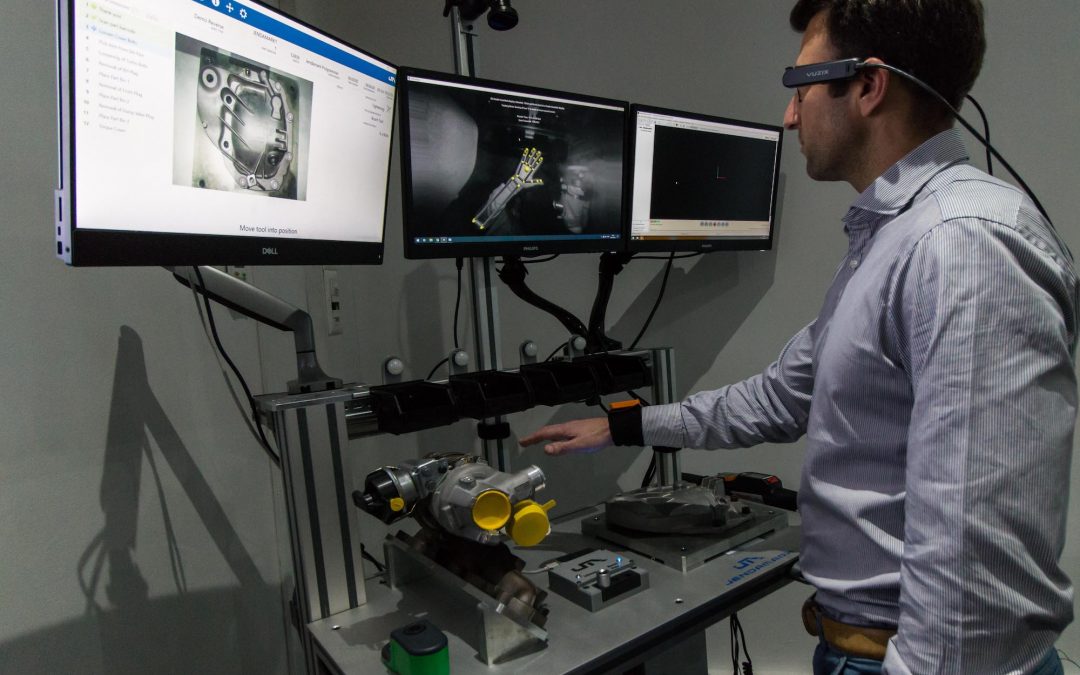
by Good News Lab | Jan 14, 2020 | Industry 4.0, Jendamark Junction, Jendamark News
Jendamark South Africa’s new tech centre is an exciting space for collaborating with customers and forging new paths on the digital transformation journey.
“As the ecosystem of digital products and services grows, we can now showcase the different offerings, as well as our partners’ technologies, while finding new ways of solving some of the toughest challenges on the production line,” says Jendamark’s manager for digital strategy and transformation, Juane Schutte.
“We have defined Industry 4.0 not as a bunch of technologies, but as a new way of collaborating in an ecosystem that works together seamlessly to provide value to our stakeholders and customers,” says Schutte.
Some of the technologies that customers can look forward to experiencing first-hand include the:
- Odin data platform – WorkStation (operator guidance system), LineWatch (real-time production dashboard) and mobile apps (end-of-line quality inspection).
- Integrated hardware – Odin smart watch, wireless bolting tools, augmented reality glasses, infrared sensors for hand and tool tracking, scanners and cameras.
- Virtual reality
– production line simulation to ensure design optimisation;
– operator training using digital worker guidance;
– development and simulation by gaming developers.
- 3D printing – printing parts for testing, new part development and prototyping.
Schutte says the tech centre also includes a giant screen for demonstrating the various capabilities to visiting groups and customers.
“It is exciting to be able to show the many practical applications for digital technologies throughout an organisation. We can help customers to improve efficiencies for operators, HR personnel, production
managers, process engineers, data scientists and more.”
So far, Jendamark has hosted visitors from all strata, including students, CEOs and government officials.
“Everyone who enters the room gains a practical understanding of how Industry 4.0 is impacting manufacturing and the future of work,” explains Schutte.
“The feedback has been phenomenal. We think this is because real collaboration has been missing between businesses and stakeholders. We find that, after visiting our tech centre, our potential customers want to bring their own children to learn and open their eyes to the ways in which the future of work will be impacted.
“We look forward to not only showcasing our tech, but also enabling eager learners to get involved and build new solutions together. Technology should not be a stumbling block but rather a great enabler for future growth.”
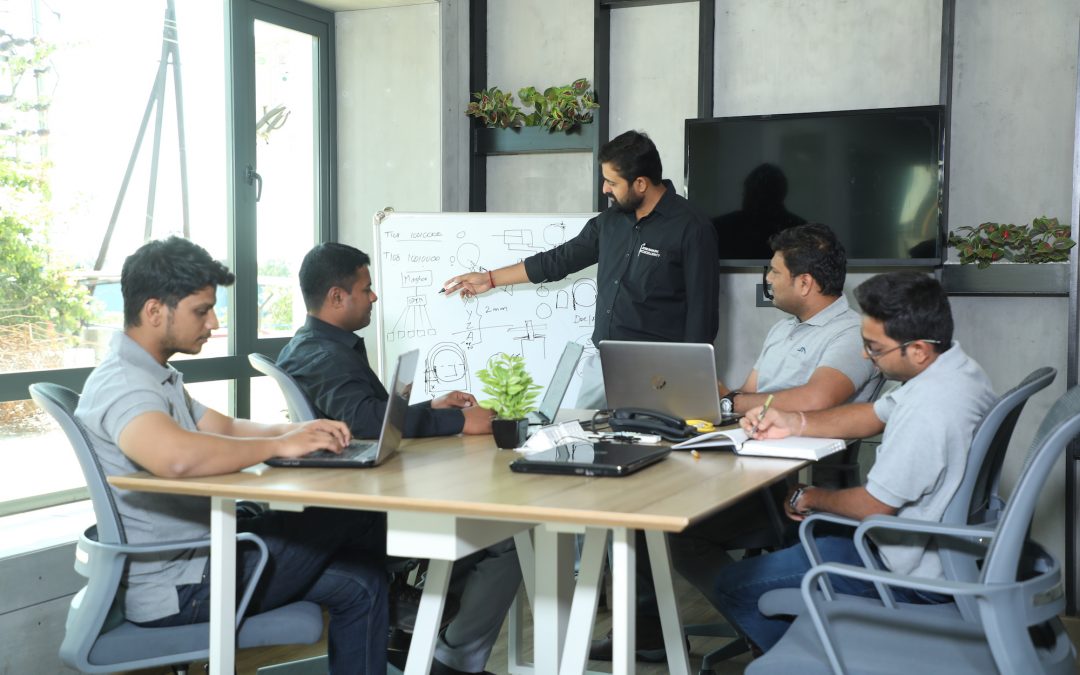
by Good News Lab | Jan 14, 2020 | Industry 4.0, Jendamark Junction, Jendamark News
Making the move from machine builder to technology company has been a natural progression for the newly rebranded Jendamark India – and one that will have huge implications for its global customers.
That’s the message from Himanshu Jadhav, who has taken the helm as chief executive offi cer and director of the new-look entity, previously known as Jendamark Techcellency.
By aligning more closely with Jendamark’s international head office in South Africa, Jadhav says, Jendamark India will be able to bring the latest solutions and technological advancements to its Asian customers.
“We are looking to move towards value creation for our customers by bringing new systems, new innovations and something new which does not exist in the current market.
“Previously, India was focused only on manufacturing. With access to this broader global offering, operating with the same vision and focus as Jendamark SA just makes much more sense.
“With this restructuring, we have re-aligned our business to focus more on automation and Industry 4.0-driven digital technology.”
Jadhav makes it clear that the Pune and Port Elizabeth plants will continue to operate in a unified manner, combining their strengths to deliver turnkey assembly facilities, but that Jendamark India’s particular understanding of the local manufacturing sector will allow it to make a unique contribution on the subcontinent.
“We will introduce our special blend and way of doing things, and gradually take more responsibility in shared customer projects. There is a lot to share and learn between the companies,” he says.
As far as the implications for customers are concerned, Jadhav says he believes they will be the biggest
beneficiaries of this positive development.
“There will be investments made in the near future in specific areas for technological advancements.
Knowledge transfer will be smoother, with our research and development team working on specific solutions needed by Indian customers,” he says.
Jendamark Automation’s operations director Siegfried Lokotsch remains in his role as chairman of the board of Jendamark India.
“The Jendamark name has always represented the highest standards in automation technology and service to the global automotive industry. We are proud of the tremendous strides Jendamark India has made since the start of our association five years ago and we are excited to continue growing in service of the booming Indian manufacturing sector,” adds Lokotsch.
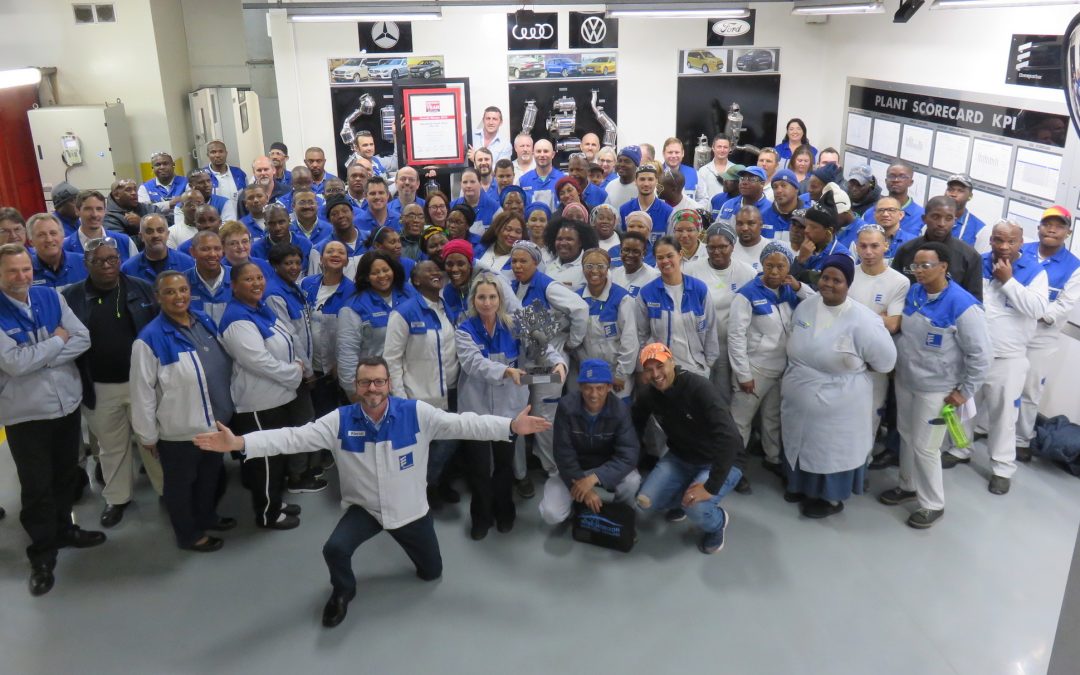
by Good News Lab | Jan 13, 2020 | Jendamark Junction, Jendamark News
Jendamark is proud to be associated with long-standing customer Eberspächer
South Africa, which recently became SA’s first recipient of the Factory of the Year award.
As a supplier to the major original equipment manufacturers (OEMs) globally, Eberspächer has become synonymous with the manufacture and assembly of catalytic converters, diesel and petrol particulate filters, mufflers, pipes and cold-end exhaust systems.
This reputation for quality was cemented this year, when the company received the inaugural South African award, which forms part of the highly prized international Factory of the Year initiative.
According to Eberspächer SA managing director Kieron Jordaan, the company was ranked in the second quintile of the global competition, having demonstrated above-average performance across the customer satisfaction, economics and quality categories.
“We also showed strong performance within the top quintile of the global competition across several benchmarks, including maintenance costs, employee productivity improvements, energy cost ratio, delivery improvements, reductions in external failure costs, and total cost of quality.”
Jordaan says the win is significant, especially in the demanding, fast-paced world created by the fourth industrial revolution.
GLOBALLY COMPETITIVE
“The automotive sector is highly competitive – this proves that we are able to produce a quality product while maintaining our costs, and motivating and
improving our workforce.
“It proves that South African firms are capable of competing against first-world companies, which is significant considering the ever-increasing demands and challenges facing not only our sector, but the country as a whole,” he says.
Over the years, Jendamark has helped Eberspächer SA with a number of solutions designed to improve efficiencies in the factory, including hard-stuffing equipment, adaptive canning lines and full assembly lines. This has been backed up by machine improvements and upgrades as well as service and maintenance support.
The relationship started back in 2011 with an upgrade to a press for the Volkswagen PQ35 project and has grown significantly since then, as tougher global emission regulations have radically altered the requirements for catalytic converter assembly facilities.
Outlining the changes, Jordaan says early products involved manual assembly stations with manual wrapping of the mat and ceramic monolith within halfshell stampings.
“Changes to the holding mat technologies, multiple variant requirements, tighter tolerances for our product as well as vehicle engine space, and a much greater emphasis on traceability and GBD, have necessitated far more sophisticated processes and equipment.
“Enter Jendamark,” he smiles.
MAJOR PROJECTS
Jendamark has gone on to build and assemble various complex pieces of equipment for some of Eberspächer SA’s major projects, as well as assisting with the upgrading of several machines since those earlier days.
“In addition, there is close co-operation on project management and technical aspects including process integration,” says Jordaan, adding that the Jendamark team’s technical expertise and support on call has made the company a trusted local supplier.
The most recently completed project was an adaptive canning line for the Ford DV-Neo programme, which is a diesel particulate filter intended for multiple vehicle assembly plants in Europe.
Developed and built by Jendamark, the line assembles the ceramic filter, support mat and stainless steel tube such that each part is unique in terms of identification, holding force and Gap Bulk Density (GBD).
And, says Jordaan, Jendamark is busy with the final assembly line for the Volkswagen MAR-Evo programme that has the start of production in 2020.
“The line has multiple stations to enable assembly of hang-on parts, leak testing, laser marking and measurement for a diesel particulate filter for a Volkswagen platform.”
Whatever the requirements, Jendamark has stepped up and responded to each project with consistent service and a desire to keep Eberspächer SA serving its customers to the best of its award-winning ability.
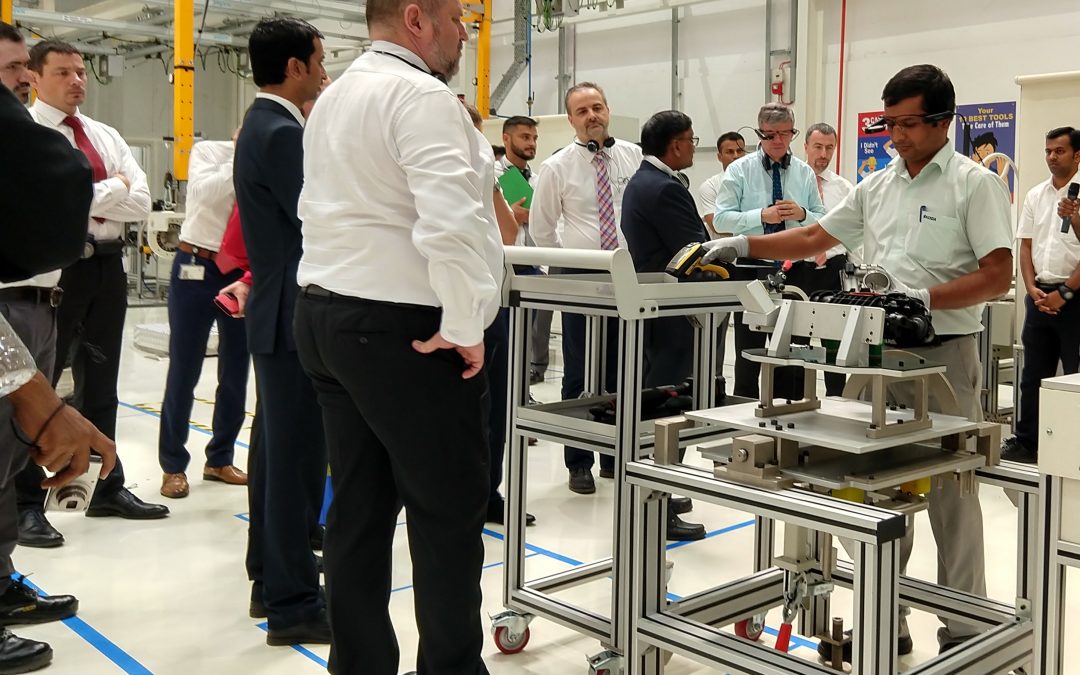
by Good News Lab | Dec 11, 2018 | Jendamark News
This year, Jendamark Techcellency (JMKT) delivered a first for India and its biggest order to date – an innovative engine assembly line that uses augmented reality to guide its operators.
In May, this line was installed in the Skoda plant in Aurangabad, where it is being used to assemble four-cylinder R4 and six-cylinder V6 engines. The €2.5 million production line, which took 10 months to complete, has successfully produced the pilot series of engines and is currently gearing up for a ramp up in volumes.
JMKT operations director Himanshu Jadhav says the Industry 4.0-driven project was not just a first for the JMKT
team but for the customer too.
“As a turnkey project, it was extremely complex and many of the aspects had never been done before. Our engineers spent a considerable amount of time understanding the requirements, coming up with innovative solutions and making it work.
“This line has several unique solutions – from a mechanical, electrical and IT point of view – which showcase our
capabilities as a leading tech-oriented company,” says Jadhav.
First among these is the use of augmented reality glasses in the production environment to guide the operator through the assembly process. There is also the extensive use of tools and gauges that transfer critical production data via a wireless network.
“All of these Industry 4.0 solutions are based on our Odin software platform,” says Jadhav.
“We also gave our customers a realistic feel for the line and a chance to suggest improvements – before a single part was manufactured – using THEIA, our virtual reality solution.”
The complete line entailed the design and manufacture of more than 300 items required for the assembly of the engine in the most cost-effective way, without compromising on quality.
Teams from South Africa, Germany and India were involved in every aspect of the project from design to execution.
“The whole global team put in long, hard hours but our passion to deliver and an uncompromising approach towards results saw us execute this project to the best of our abilities and ensure customer satisfaction.”
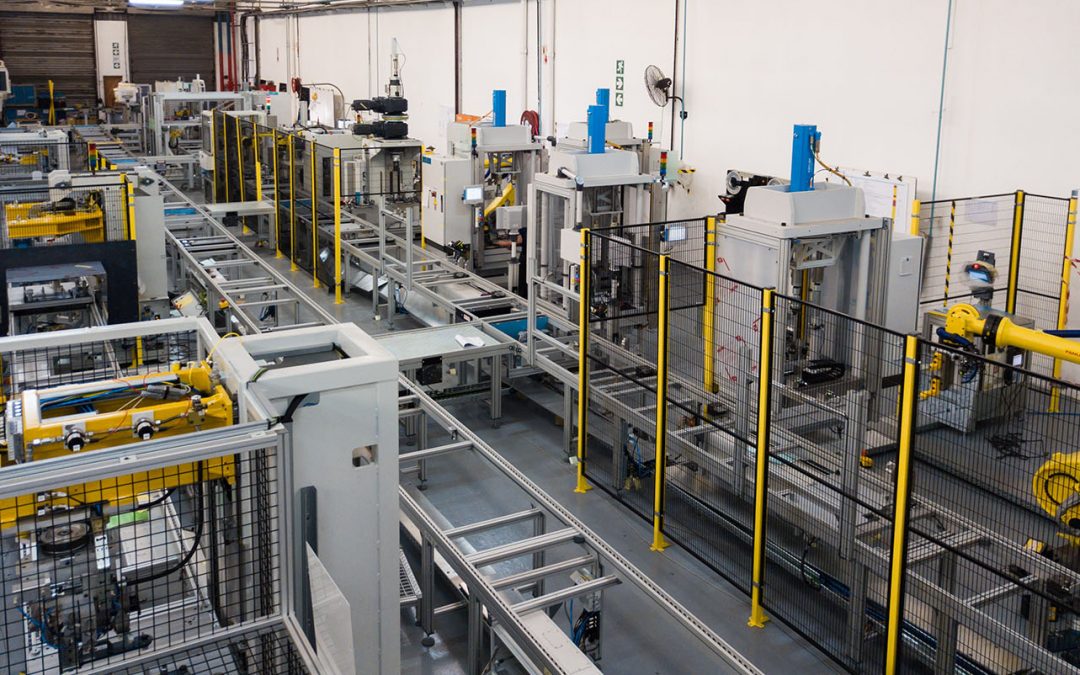
by Good News Lab | Dec 7, 2018 | Jendamark News
Jendamark continues to push the boundaries of possibility with its longest and most automated powertrain production line so far. This differential assembly line is also the largest single-order project ever to be completed by the Group.
Designed to assemble the GM-A2xx platform differentials for General Motors, the line has been installed for ZF at their Gainesville facility in Georgia in the United States.
Jendamark’s head of powertrain assembly, Johan Labuschagne, says the project turnaround time was 12 months, as the entire line had to be designed from scratch.
“No existing machine designs could work for this specific product, except our pinion nut tightening machine, which also had to be modified,” says Labuschagne, adding that it was the first full differential assembly line supplied by Jendamark in 15 years.
“Our R&D experts guided the design team and from there we relied on our vast experience with manufacturing, assembly and commissioning to bring this production line to life.”
It was also the first line to use the latest version of Jendamark’s production and line management software, Odin.
This was particularly important as the assembly process involves gauging to select the right parts for optimum performance of the differential unit, and testing – including a backlash measurement and leak testing – to verify that the assembly process was done correctly.
“Its value has been proven, and we have received an order for another production line using Odin from the same customer,” says Labuschagne.
“We faced some serious hurdles, but the team put in the necessary research and hours to get the project over the finish line. Everyone can feel proud that we delivered a good product and won the customer’s confidence for future projects.”
THE BIG NUMBERS:
Total floor area: 50m x 22m
Total conveyor length: 130m
Machine footprint: 46m
Design: Loop conveyor system
Working stations: 18
Operators: 8
Robots: 5 (plus 1 installed by customer)
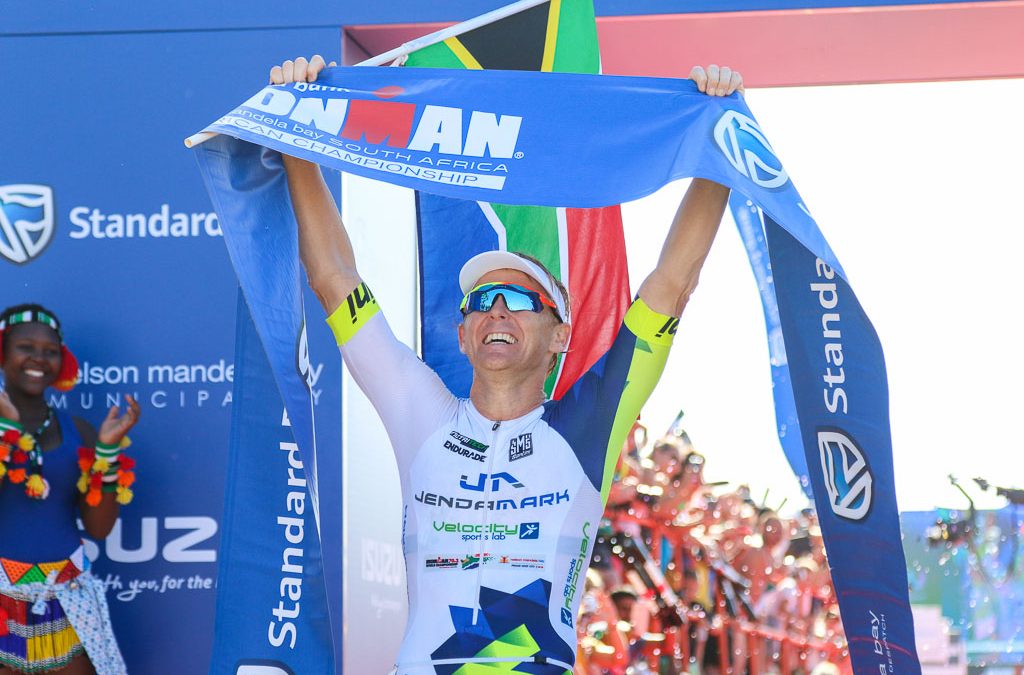
by Good News Lab | Dec 7, 2018 | Jendamark News
Jendamark-sponsored Ironman African champion Kyle Buckingham shares the highs and lows of being a professional triathlete and what makes him take on these super-human feats of endurance.
Q:You and Jendamark share the same home town of Port Elizabeth. What makes the city such a great training ground for you?
A: There is a lot of variety on my bike rides; I can practise on the Ironman Africa race course or head outside the city to tackle some hills. There is also great running where I live in Sardinia Bay. Plus, there’s a handful of quality pools to choose from for my swim and, of course, the Indian Ocean.
Q: What drives you to push the limits of your physical endurance in not one but three disciplines?
A: I love the challenge. I didn’t get the opportunity to try out any other sport beside Ironman when I was younger. I came across it by accident and found I was pretty good at it after finishing my first race.
Q: What has Jendamark’s sponsorship enabled you to do in your career?
A: My sponsorship with Jendamark has allowed me to train full time as a professional triathlete and race not only in South Africa but abroad too.
Q: What does your average training day look like?
A: On a typical day, I will train for at least six to eight hours on all three disciplines. I start with my bike ride – anywhere between two and seven hours. Then I head to the pool at lunchtime and swim four to five kilometres. After lunch I will have an afternoon sleep to recover before finishing off my day with a 45 to 90-minute run in the evening.
Q: How do you fuel your training? What does your daily diet look like?
A: I have pretty normal meals, consisting mainly of good proteins, high fats and lower carbs. When I train, I use energy drinks to help with electrolyte replacement and calories. I burn between 3 000 and 6 000 calories per day. I also take a recovery shake to add a larger number of calories into my diet than food can.
Q: How many pairs of running shoes do you wear out in a year?
A: I go through roughly five pairs of running shoes for training and I use a brand-new pair of racing shoes for every race. So that’s about another four or five pairs of racers.
Q: When you’re struggling on the run/swim/cycle, how do you motivate yourself? What do you think about during those long hours?
A: I think about winning my next event – it is always on my mind. When racing, I think about those long hard days in training that I do. I also think to myself that, when my race career is over, I want to look back and say that I gave my best effort – and not that I should have trained harder!
Q: Was winning the Ironman Africa Championship in your hometown the high point of your career so far?
A: Absolutely, YES!
Q: What’s your favourite memory from the day?
A: My favourite memory is running past my family on Marine Drive. They were all screaming for me and telling me I look amazing, and I just kept thinking, “I feel incredible. I feel like I am walking on water.”
Q: What are some other career highlights?
A: I will never forget the feeling of winning my first-ever Ironman at Ironman Lake Placid in 2014 in my first year as a pro. Another highlight was taking the overall course record at Ironman World Championships in Kona as an age-grouper in 2013 – and still holding that record today.
Q: What has been one of your serious lowlights? And how did you move past it?
A: In October 2017, I had a very upsetting race at the Ironman World Championships in Hawaii. I was in the absolute best shape and form of my life. Predictions and numbers were showing that I should be in a great position to finish top 10 overall. Then my race didn’t go as planned. I had a mechanical on the bike and was the last male pro to finish that leg. Looking back, I might have also picked up a virus that I didn’t know I had. On the morning of the race I could not stop sweating, which, looking back, should have been a red flag for me. The night after the race I was extremely ill and almost couldn’t catch my return flight home. I was sick for an entire month and slept day and night for the first five days. To get over the disappointment, I had to remind myself why I chose this sport and of the love I have for it. I also had to remind myself that I have a lot of people who support me and surround me with so much positivity. This encouraged me to get my fight back and start my training again.
Q: What are your plans and major goals for 2019?
A: My number one goal is to defend my title at Ironman African Champs in April and also to improve my position at the Ironman World Champs in Hawaii.





